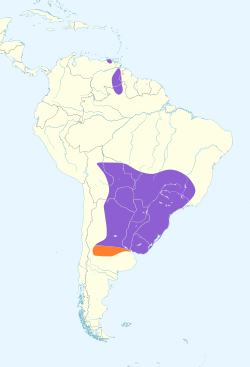Breeding
The nest of the tawny-headed swallow is cup-shaped and made of leaves, feathers, and straw. It usually measures 20–50 cm (7.9–20 in) in length and 7–10 cm (2.8–3.9 in) in width. The nest usually has a diameter of around 5–6 cm (2.0–2.4 in), a depth of 0.5–3 cm (0.20–1.18 in), and a height of 5–6 cm (2.0–2.4 in). The nest is constructed by both the male and female, usually over a period of 10 or 12 days. The nest can be found in hidden holes along rivers, streams, and ditches. [10] The holes are usually at least 1 m (3.3 ft) deep, with a compartment at the end, where the nest is placed. Further research is required to determine whether this bird digs its own burrow or whether it steals tunnels from other species. [10] The tawny-headed swallow usually nests in pairs or loose groups. [9]
The breeding season of the northern population is suspected to occur during May and June, although it is not particularly well-known. The southern population's breeding season occurs from September to November. Other than this information, nothing is known about when its breeding season occurs. [10] [9]
The tawny-headed swallow, in Argentina, at least, has a clutch of four to five white eggs. The eggs measure 17 mm–19 mm × 12 mm–13.9 mm (0.67 in–0.75 in × 0.47 in–0.55 in) and weigh, on average, 1.5 g (0.053 oz). [10] [9]
Diet
This swallow subsists on a diet of insects, primarily beetles, flies, and hymenopterans. It usually forages in pairs and small groups, although larger groups, up to 100 individuals, have been recorded when not in the breeding season. Although it is usually not seen with other swallows, it has been seen with wintering barn swallows. [10] [9]


